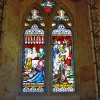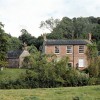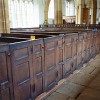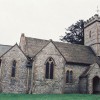The parish of Wimborne St. Giles extends to nearly 6,000 acres from the East Dorset heath land in the south-east north-westwards to the edge of Cranborne Chase; in the middle is the village that gives its name to the parish and in the middle of the village is the parish church.
Hutchins records that in 1732 the nave and the tower of St. Giles Church were almost entirely rebuilt. Similarities with the church of St. Peter and St. Paul at Blanford have led to speculation that the architects were the brothers John and William Bastard, although no documentary evidence exists to support this opinion. In 1887 north and south arcades designed by G.F. Bodley were incorporated into the nave and a north chapel was added. Fire struck the church in 1908 destroying everything except the tower and two walls of the 18th century nave.
A report from the time tells us that on Tuesday the 29th of September workmen had been doing lead soldering work in the tower rafters. At about eleven o’clock on Wednesday evening Thomas Blake, George Bennett and Walter Cutler, all estate workers, noticed smoke coming from the top of the tower; they obtained a key and took buckets of water up and put-out the fire. The fire rekindled itself and at thirty minutes past one o’clock on the morning of the 1st of October the bells, which had been left in the up position after ringing practice, were released by the flames licking around the belfry; they started ringing and raised the alarm.
Many villagers turned out of bed including the Rev. J. Bouquet and Police Constable Arnold. Mr A.S. Wilbratham (the Shaftesbury’s estate manager) carried out church fittings including some recently purchased new oak benches, the pulpit, altar table and linen, thirty-five chairs and the church registers. First light revealed all that remained was a burnt out shell.
What we see today is a church rebuilt and refitted to the plans of Sir Ninian Comper but his work here has not met with universal acclaim. Pevsner in the Dorset edition of his ‘Buildings of England’ series criticises both structure and fittings. Appearing as an early Georgian building the walls are of Greensand ashlar chequered with panels of squared and knapped flint, and slate covered roofs. The church comprises a west tower, home to eight bells; nave; south porch; chancel; north aisle; north chapel and vestry.
The chancel and nave are structurally one separated by an oak rood screen which continues into the north aisle. Some are critical of the way Comper “tampered” with the inside creating a “preposterously” narrow south aisle separated from the nave by tall round piers. The seating in the nave is by Comper but the benches in the north aisle are those saved from the 1908 fire, as is the carved wood pulpit. The screen, very Gothic in appearance and also by Comper; the adjoining box is the Shaftesbury pew. Also by Comper is the West Gallery of wainscot oak; it has seating for choir and bell ringers and holds a fine organ. The Royal Arms on the front of the gallery are those of George II.
The west tower is in three stages with the lower two stages having corner buttresses. At the top a plain parapet with a balustraded panel at the centre of each side and at each corner a stone vase with a cast iron finial. Under the tower is the west door leading into a fine wide vestibule
The east window above the altar, a memorial to the 8th Earl of Shaftesbury and Harriet his wife, is by Comper. The small window at the east endof the south wall above the Shaftesbury family entrance depicts Mary the Mother of Jesus and is a memorial to Mary Sibell, a daughter of the 9th Earl. East of the south porch entrance is a window reconstructed from fragments of German and Flemish glass collected after the fire from a window originally given by the 5th Earl in 1785. To the west of the south porch one small light commemorates the golden wedding of the 9th Earl and his wife Constance in 1949. The other light is a memorial to the Rev. Robert Harkness, Rector here at the time of the 7th Earl.
On the west wall at the back of the gallery a window of five lights is made up of two windows formerly in the north wall; they survived the 1908 fire. On the north wall in the gallery is another window by Comper to commemorate the silver wedding of the 9th Earl and his wife. Under the gallery a small window by Comper serves as a memorial to Miss Edith Milner a friend of the 9th Earl and his wife. The two large north wall windows are in memory of the 7th Earl of Shaftesbury and his wife Emily and the second is a memorial to Mrs John Ashley. The window behind the large Jacobean tomb in the North Chapel is “A Commemoration of the Coronation of King George V” on June 22nd 1911 and is also by Comper who is also responsible for the window over the Lady Chapel Altar – a memorial to the Duke of Westminster who died at St. Giles House.
To the right hand side of the Altar is an unusual memorial. It seems that during the building of the arcade in 1887 a robin nested here. The workmen of the time placed the nest and a letter in a bottle and this was discovered during the work carried out after the 1908 fire when another robin nested in the same spot. The bottle and the second nest have been replaced in the wall and the spot is known as The Robin Memorial.
Of the many monuments to the Ashley-Cooper family Pevsner says “the Ashley monuments are a splendid series, though desperately displayed. If only a museum-like mausoleum or gallery could be built for them.”
There is a memorial to the 7th Earl in the family pew in the south wall and he is buried in the family vault under the north side of the church. Also in the south wall, a much restored monument of a crusader believed to be Sir John de Plecy who died in 1313. The Plecy’s are Shaftesbury ancestors.
In the north wall is a memorial to the 1st Earl of Shaftesbury complete with a bust of the man. Lower down there are three carved female heads representing the Earl’s three wives. Other memorials recall the lives of the 3rd Earl who was a philosopher and the 4th Earl who was a friend of Handel. It was the 4th Earl who built the 18th century church. The grand tomb in the Lady Chapel is that of Sir Anthony Ashley.
Since 1672 when Anthony Ashley Cooper was created the 1st Earl of Shaftesbury the family have played an important and distinguished part in the history of England. For six hundred years the family seat has been at Wimborne St. Giles and St Giles House, the grand building we see today, was built in the mid 17th century replacing a modest manor house that originally stood on the site. The house is not open to the public but a visit to the parish church of St. Giles will tell you much about the family’s history.




